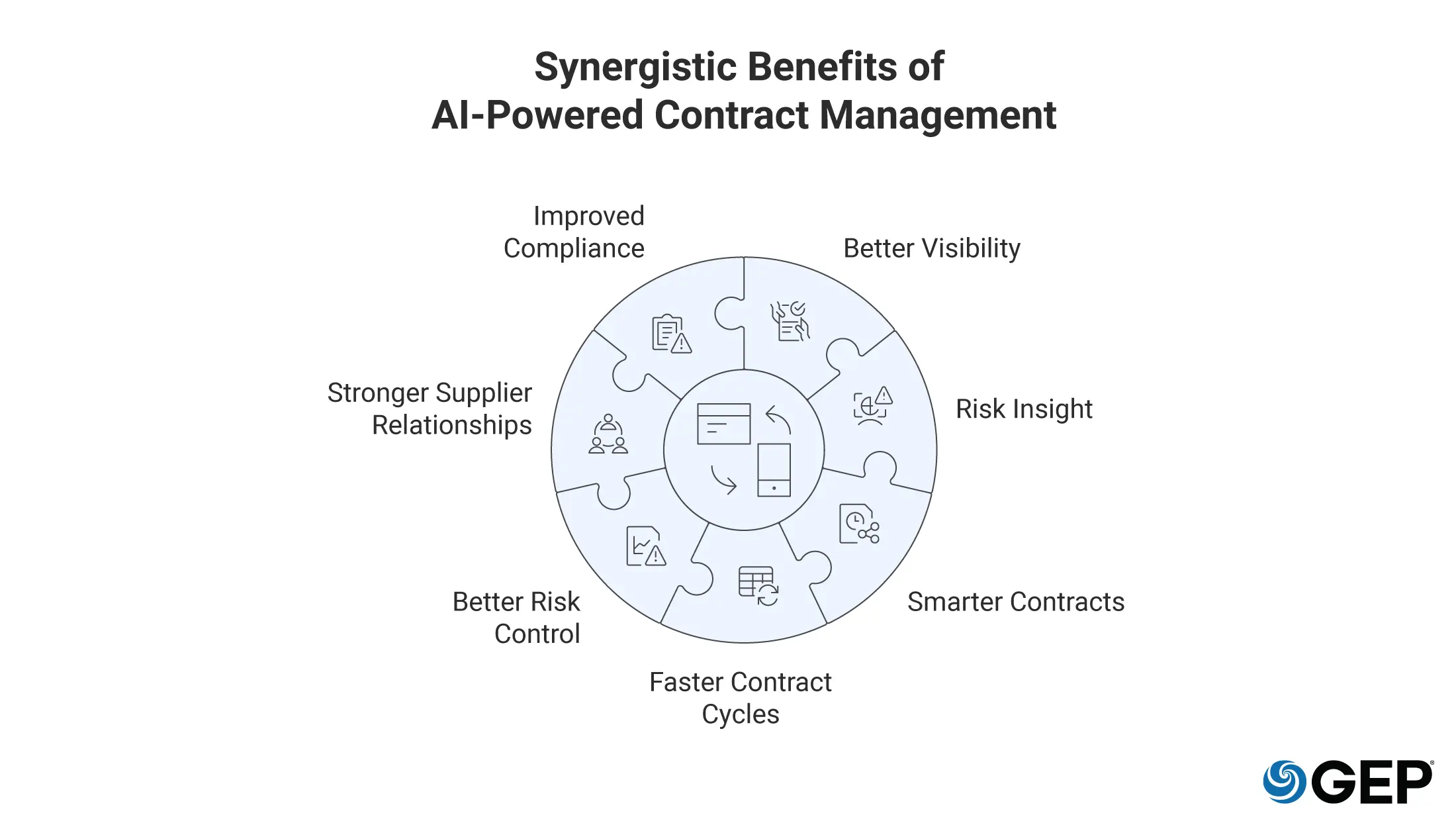
How AI Can Turbocharge Your Contract Lifecycle Maturity
- Many companies still use basic contract lifecycle management (CLM) solutions, missing chances for better insight and automation.
- AI-powered CLM tools help procurement teams manage risk, obligations, and performance proactively.
- Reaching full CLM maturity requires better integration, governance and leadership.
October 17, 2025 | Procurement Software 5 minutes read
You’ve just signed a contract with a supplier. Now what? That document is the only way to hold parties accountable for fulfilling obligations, so you have to watch it carefully to ensure everyone is complying with what they agreed to.
But this contract document is misplaced or lost in the huge amount of paperwork. And this happens more often than you would like.
Why are supplier contracts signed, filed and then forgotten? This puts to waste all the hard work done on negotiating favorable terms and pricing. How can procurement turn contractual terms into reality and derive actual benefits? Let’s find out.
AI: A Game-Changer for CLM
AI is changing how organizations manage contracts, speeding up the shift from simple document storage to smarter, more strategic contract management. While many companies are stuck in the early stages of CLM, AI can help them advance and reach levels of maturity that once took years.
Traditionally, CLM maturity follows a slow, step-by-step path. Teams build basic processes, then work toward more advanced capabilities. AI changes this path completely. With AI, companies can jump ahead by automating tasks that used to take teams weeks or months to handle manually.
Older CLM tools focus on writing contracts, storing them, and collecting signatures. These systems are mostly reactive. But AI brings predictive and proactive power. Natural language processing can read and analyze millions of contract pages. Machine learning spots patterns, risks and outliers. And generative AI helps write and review contracts using historical data and knowledge.
AI turns contract data into business insights and frees procurement teams from administrative work, enabling them to focus on strategy.
The AI-Powered CLM Maturity Model
AI helps organizations advance through the different stages of CLM maturity, with each AI capability building on the last, delivering more value at each step.
Stage 1: Smarter Contract Intelligence
With better contract visibility, AI goes far beyond basic keyword search. It reads contracts and automatically extracts key details like clauses, deadlines and obligations.
Natural language processing capabilities lets teams ask deeper questions of the AI, like which contracts include a specific clause, or which vendors present the highest risk.
AI can also flag missing or unusual terms. This kind of contract intelligence is vital for effectively managing risk, performance or compliance.
Stage 2: Predictive Risk and Obligation Management
Next, AI helps teams see problems coming and stop them before they happen. It maintains a constant eye on contracts to identify risks or missed obligations.
AI algorithms can forecast problems like vague clauses, missing deadlines, or suppliers not doing their jobs well by looking at prior data and market trends. When AI sees a risk, it provides repairs, tells you what to do next, and tells you what to do first.
This makes keeping track of obligations a smart, automated job. AI gets better at finding and stopping threats before they do actual damage by learning from what it sees and does.
Stage 3: Intelligent Contract Creation
AI can also help write better contracts faster. It studies past contracts and outcomes, finding clauses, terms and structures that work best, which helps teams create smarter templates and suggest stronger contract language.
AI-driven workflows route contracts to the right reviewers, suggest negotiation positions and flag common errors. As more contracts are created, the system keeps learning and improving.
This feedback loop helps teams build better contracts each time, reducing friction and improving results.
Stage 4: Performance-Driven Optimization
At the highest level, AI turns contracts into living tools that adapt to real-world performance. It continuously compares contract terms against supplier performance, market shifts and regulations.
In the event of a regulatory change or a poor supplier delivery, AI can recommend updates, flag issues or even propose new terms. It can also apply bulk updates to groups of contracts while preserving each contract’s integrity.
This creates a smarter contract environment where deals adjust to fit business goals, not just renewal dates. Contracts become tools for managing performance, not just paperwork.
The Power of Compounding Benefits
Companies that use AI in CLM often see faster results than those using traditional methods. That’s because each AI capability boosts the next.
- Better visibility supports better risk predictions.
- Better risk insight informs better contract drafting.
- Smarter contracts make performance easier to track and improve.
Faster contract cycles, better risk control, stronger supplier relationships and improved compliance: all reasons to make AI-powered CLM part of your strategy.
Unlock the Value in Your Contracts
Discover how AI-powered CLM protects your business
What’s Holding CLM Back?
Even with all this potential, AI adoption still comes with challenges. Four common hurdles include:
1. Data Quality
AI needs clean, structured data to work optimally. Legacy contracts are often messy, scattered across systems, inconsistently formatted or missing key details. Invest in data cleanup and ongoing data management to get the most from AI.
2. Trust in AI
If people don’t trust AI recommendations, they won’t use them. So take time to explain how AI makes decisions and provide clear logic behind its suggestions. Start with a small-scale use case to demonstrate value and build confidence over time.
3. AI Governance
With advanced tools come new responsibilities. Teams need policies to manage how AI is used, monitor its performance and ensure compliance with data and AI regulations. This governance should align with your broader contract policies.
4. Integration Challenges
AI systems need access to data from across the business, like legal, finance and procurement. Integrating AI-powered CLM into enterprise systems requires thoughtful planning and strong change management, which can be a source of issues.
How to Start Your AI-Driven CLM Journey
To get the most out of AI in CLM, companies should focus on three key steps:
1. Check if you're ready
Check the quality of your data, how well your systems work together, and how ready your staff is. Find places where AI can aid right away and places where you need to create a base first.
2. Start with a small amount
Use AI for a specific task, like getting metadata or highlighting renewal concerns, in a test project. Use these wins to get others on your side and keep things moving.
3. Design for intelligence
Rather than just automating workflows, think about how AI could change how you work. Don't only use its insights to make decisions faster. Use them to make better judgments.
Ready for AI Adoption?
AI is accelerating the entire maturity process for CLM. It’s enabling better visibility, enhancing risk identification, writing better contracts and improving performance in ways that were once out of reach.
Smarter CLM means better decisions, faster action and stronger results.
Don't worry about whether AI will reshape contract management. Focus on how quickly your team can leverage AI to develop its contract management capabilities.




